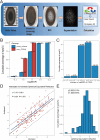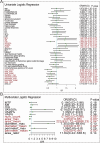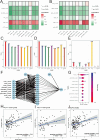Posterior lenticule laser scan influence the ultra-early postoperative visual acuity and quality of SMILE
- PMID: 39511370
- PMCID: PMC11544260
- DOI: 10.1038/s41598-024-78080-4
Posterior lenticule laser scan influence the ultra-early postoperative visual acuity and quality of SMILE
Abstract
This is a prospective case-control study investigated the factors influencing ultra-early visual acuity and quality after Small Incision Lenticule Extraction (SMILE) surgery, with a specific focus on the morphology and distribution of "black clefts" observed in posterior lenticule laser scanning images. A total of 174 patients who underwent SMILE surgery were included, and their preoperative ocular clinical parameters, visual quality indicators, and posterior lenticule laser scanning images were analyzed. The morphological features of black clefts were calculated using image processing techniques. Univariate and multivariate logistic analyses were conducted to identify factors impacting ultra-early visual acuity recovery, while correlation analysis was used to explore the association between black cleft morphology and postoperative visual quality. The results showed that although patients experienced significant visual acuity improvement one day after surgery, 26% had poor early recovery. Postoperative visual quality parameters were significantly lower, while the Object Scatter Index (OSI) was higher compared to preoperative values. Patients with poor visual recovery had a higher number of irregular black clefts in their laser scanning images. Logistic regression analysis revealed that intraoperative morphological parameters of black clefts were independent factors influencing early postoperative visual acuity recovery. Additionally, correlation analysis demonstrated a negative correlation between black cleft morphology and postoperative visual quality parameters, and a positive correlation with OSI. In conclusion, the morphology and distribution of black clefts during SMILE surgery significantly affect ultra-early postoperative visual acuity and quality, with increased variability in black cleft area leading to higher OSI, thereby impacting visual quality recovery.
Keywords: Black clefts; Morphology; SMILE; Scanning image; Visual quality.
© 2024. The Author(s).
Conflict of interest statement
The authors declare no competing interests.
Figures





Similar articles
-
Comparison of objective and subjective visual quality early after implantable collamer lens V4c (ICL V4c) and small incision lenticule extraction (SMILE) for high myopia correction.Acta Ophthalmol. 2020 Dec;98(8):e943-e950. doi: 10.1111/aos.14459. Epub 2020 May 18. Acta Ophthalmol. 2020. PMID: 32419383
-
SMILE With Low Energy Levels: Assessment of Early Visual and Optical Quality Recovery.J Refract Surg. 2019 May 1;35(5):285-293. doi: 10.3928/1081597X-20190416-01. J Refract Surg. 2019. PMID: 31059577
-
Association of myopia and astigmatism with postoperative ocular high order aberration after small incision lenticule extraction.BMC Ophthalmol. 2024 May 13;24(1):211. doi: 10.1186/s12886-024-03475-w. BMC Ophthalmol. 2024. PMID: 38741093 Free PMC article.
-
Optical and visual quality after small-incision lenticule extraction.J Cataract Refract Surg. 2019 Jan;45(1):54-61. doi: 10.1016/j.jcrs.2018.08.026. Epub 2018 Nov 1. J Cataract Refract Surg. 2019. PMID: 30391154
-
Visual Quality After Femtosecond Laser Small Incision Lenticule Extraction.Asia Pac J Ophthalmol (Phila). 2017 Sep-Oct;6(5):465-468. doi: 10.22608/APO.2016171. Epub 2017 Mar 29. Asia Pac J Ophthalmol (Phila). 2017. PMID: 28379651 Review.
References
-
- Huang, G. & Melki, S. Small incision Lenticule extraction (smile): Myths and realities. Semin Ophthalmol.36, 140–148 (2021). - PubMed
-
- Sekundo, W., Kunert, K. S. & Blum, M. Small incision corneal refractive surgery using the small incision lenticule extraction (smile) Procedure for the correction of myopia and myopic astigmatism: Results of a 6 Month prospective study. Br. J. Ophthalmol.95, 335–339 (2011). - PubMed
-
- Ahmed, A. A. & Hatch, K. M. Advantages of small incision lenticule extraction (smile) for mass eye and ear special issue. Semin Ophthalmol.35, 224–231 (2020). - PubMed
-
- Reinstein, D. Z. et al. Small incision Lenticule extraction (smile) for the correction of high myopia with astigmatism. J. Refract. Surg.38, 262–271 (2022). - PubMed
MeSH terms
LinkOut - more resources
Full Text Sources
Medical

